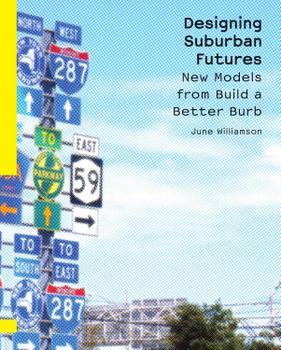
Cover of "Designing Suburban Futures"
New book by Spitzer School of Architecture’s June Williamson seeks to increase ‘Design DNA’ for place where most North Americans live
In 2010, June Williamson, associate professor of architecture at The City College of New York’s Spitzer School of Architecture, organized and ran a design competition for the Long Island Index, a not-for-profit that conducts research on regional issues. Ideas from that contest, which challenged entrants to creatively retrofit Long Island’s existing downtown areas, provide the foundation for her new book, “Designing Suburban Futures: New Models from Build a Better Burb.”
Targeted at the design community, the book, which was released in May by Island Press, exposes and engages its audience to the challenges and opportunities found in suburbia. “The point of the book is to showcase new tactical ideas that came out of the design competition and to frame them in ways that could be inspiring to designers, policy makers and planners,” Professor Williamson explains.
Once the symbol of the American dream, suburbs have been beset in the 21st century with an array of problems, among them aging infrastructure and population, high property taxes and energy costs and increasing congestion and sprawl. Many designers have shunned the suburbs in favor of urban environments; they consider them bland and boring.
However, Professor Williamson points out that the majority of North Americans live in the suburbs and the challenges faced there “require us to focus on the suburban landscape. Design has a role to play in making suburbia more resilient.” In an earlier book, “Retrofitting Suburbia,” co-written with Ellen Dunham-Jones (John Wiley & Sons, 2009, 2011) she presented creative examples of reuses for shopping malls and other suburban building types.
Those challenges are multifaceted and occur at the lot, neighborhood and regional scale. Effective design is needed to support economic activity while improving mobility and reducing carbon footprints. Among the strategies she advocates for achieving these aims are more infill development and mixed use development.
Some of the ideas from the competition at the lot scale include: adapting “big box” store buildings for new uses; creating plazas and other public spaces to enhance civic life, and new housing types that support aging in place and intergenerational households.
For neighborhood scale development, proposals included: establishing satellite facilities for big city cultural institutions such as museums and performing arts centers; using school buses during the day to provide local public transportation, and converting excess parking lots to farming.
Regional responses dealt with issues such as carbon sequestration, water conservation and governance. Some designers, for example, recommended reshaping political boundaries and eliminating duplication so areas could be governed and resources shared more efficiently.
Professor Williamson says she hopes her book and competitions such as “Build a Better Burb” will bring new voices to the conversation about suburbia and “increase the design DNA floating around.” By circulating ideas, bits of the best stuff can eventually find their ways into projects.
Given that suburbia’s current situation reflects 50 – 60 years of investment in a growth and expansion driven auto-based development pattern, she expects retrofitting to take an equivalent amount of time. Much of the suburban lifestyle is likely to retain its character, with detached houses remaining the dominant form, she notes, adding, however, that old assumptions people have about location choices need to be rethought.
“The reasons people moved to the suburbs a generation ago aren’t the same reasons they move to them today.” To provide a superior choice to what exists in center cities, the suburbs need to think beyond the growth machine proposition, she argues. “They will need to create places that are inviting to different populations and cultures, and address public health needs through physical design by becoming more walkable and bikable.”
Part of the challenge will involve getting change-resistant communities to revise their building and zoning codes. “There is a lot of great stuff happening in suburbia – Long Island and elsewhere – but people need to ask how to remove obstacles and red tape,” says Professor Williamson, who was raised in the suburbs of cities like Boston, New Orleans and Pittsburgh.
“My message is you can go back to the suburbs and improve communities by using your design skills. As an academic, getting examples of what can be done into books and circulating them is helpful to people on the ground trying to make the argument. If they can show what is possible, they can take on the NIMBYs (not in my back yard).”
On the Internet
MEDIA CONTACT
Ellis Simon
p: 212.650.6460
e:
esimon@ccny.cuny.edu